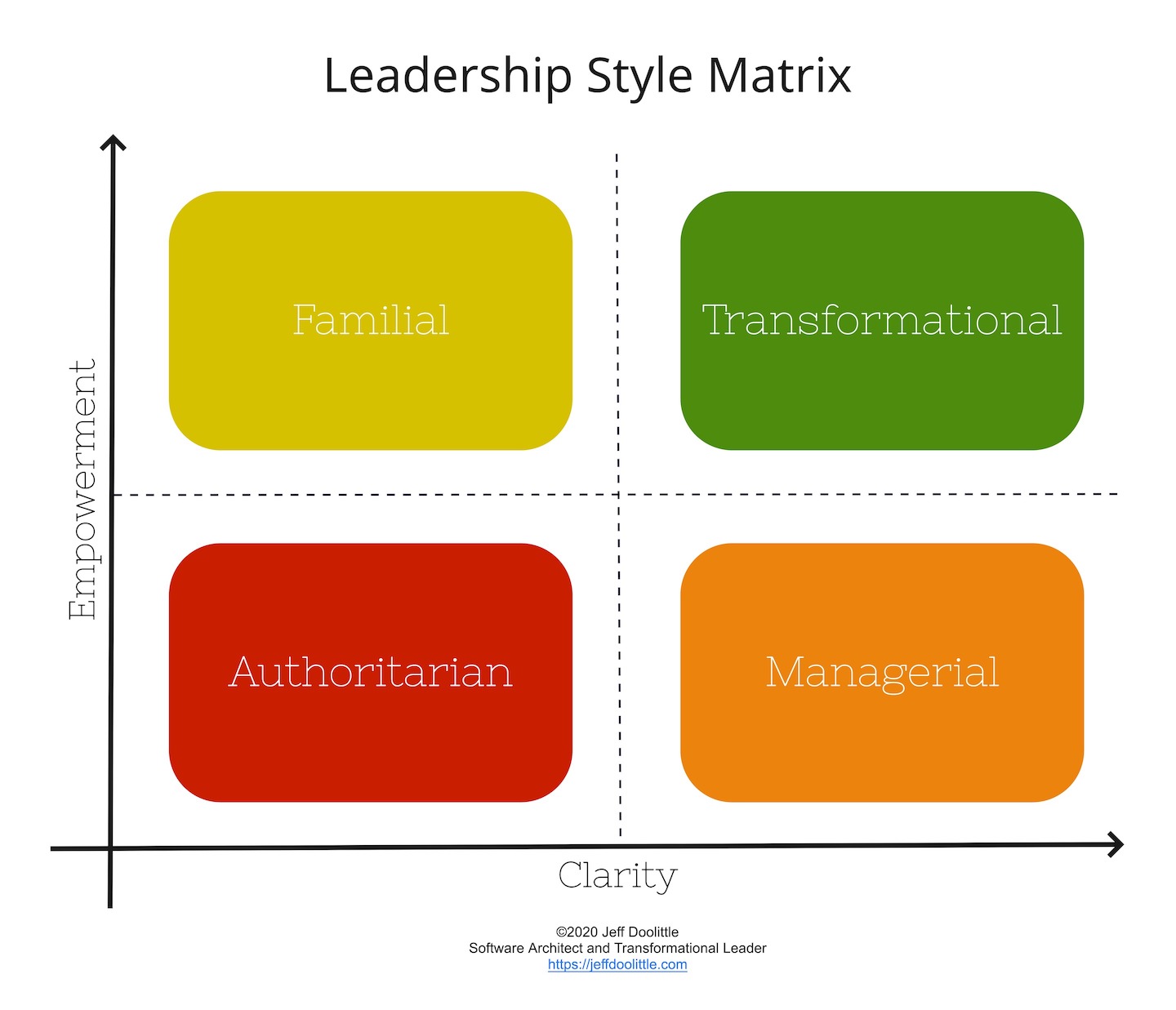The Leadership Style Matrix
Learn to apply the right leadership style in the right situation.
In my recent article Software Leadership Distilled1, I described the importance of three core values: trust, clarity and empowerment.
The Leadership Style Matrix visualizes how clarity and empowerment relate to four leadership styles: authoritarian, managerial, familial and transformational. Each of these styles may be effective and even necessary depending on the situation. However misapplication of a style in an inappropriate context hampers desirable outcomes.
A leader may change styles depending on the situation or context. Style variations may occur due to various factors such as recent events, personal stress and anxiety, time of day or mood, or interactions with different individuals or groups.

Authoritarian
Authoritarian leadership emerges in environments low on empowerment and lacking in clarity. Such a context leaves little to no room for autonomy. Without foundational clarity, authentic trust cannot be built. This does not necessarily prevent an authoritarian leader from attempting to demand or mandate trust. Authoritarian leaders may purposefully increase ambiguity and can tend to take arbirary actions.
Crisis situations may call for the authoritarian style. However its consistent application stifles trust, autonomy, and innovation. The perpetual authoritarian crushes personal ownership, responsibility and accountability. Fragile trust may exist between the consistent authoritarian leader and certain individuals, but its arbitrary nature places it on an unstable foundation. Authoritarian leaders manage situations by controlling narratives and delegating authority only to a circle of relatively predictable and conformative individuals.
Authoritarian success metrics can change at the whim of the authoritarian leader, leaving group members confused and even fearful.
Managerial
Managerial leadership provides much needed clarity but neglects to cultivate empowerment. Trust can grow in such an environment since clarity enables the making and keeping of agreements.2
This style can work well when standardized practices provide clear value creation expectations. Managerial leaders provide additional clarity by defining and refining processes and practices where standardized practices do not exist.
Misapplication of this style often results in micromanagement of tasks, excessive meetings and frequent “looking over the shoulder” of group members. At worst it devolves into management of people rather than processes.
Managerial success metrics relate to standardized procedures and processes. These metrics can prove sufficient when group members do not feel a strong need for personal creativity, autonomy and innovation in their work.
Familial
The familial leader cultivates a sense of empowerment in situations where ambiguity exceeds clarity. With this style trust grows from loyalty, personal history and other interpersonal factors.
In some naturally ambiguous situations the familial leader can foster group cohesion despite a lack of value creation clarity. Fierce loyalty can characterize some group members under the familial leader, while others may become frustrated at what they interpret as double-standards and playing favorites.
Familial leadership can devolve into transactional relationships built on a quid-pro-quo foundation. Subtle passive-aggression may become commonplace. Long term employment of the familial leadership style suffers from arbitrariness similar to the authoritarian style, but with a smile on it.
The familial leader leaves value creation expectations unclear or undefined.
Familial leaders measure group member success through feelings of loyalty, shared points of view and conformity to group norms reinforced by the familial leader and the group itself.
Transformational
Transformational leaders catalyze leadership in others. They work to enable a healthy environment where trust can grow naturally. Every group experiences a lack of empowerment at times. Transformational leaders discover creative ways to shore it up. They frequently and consistently guide the group toward mutually self-reinforcing empowerment.
Upon discovering ambiguity regarding value creation expectations, the transformational leader takes necessary action to resolve the ambiguity as quickly and efficiently as possible. They regularly evaluate the fitness and alignment of group members for their individual primary responsibility.
Transformational leaders may manage in the sense of helping to define processes and practices, but they avoid managing people.
Transformational success metrics involve personal responsibility for individual primary responsibility and group member effectiveness in building trust, fighting for clarity, and empowering others in the group.
Recommended Reading
-
David J. Snowden and Mary E. Boone, Cynefin - A Leaders Framework for Decision Making
-
Dr. Ron Claassen, A Peacemaking Model
Footnotes
The Leadership Style Matrix originally appeared at jeffdoolittle.com.
Copyright © 2020 Jeff Doolittle. All rights reserved.

